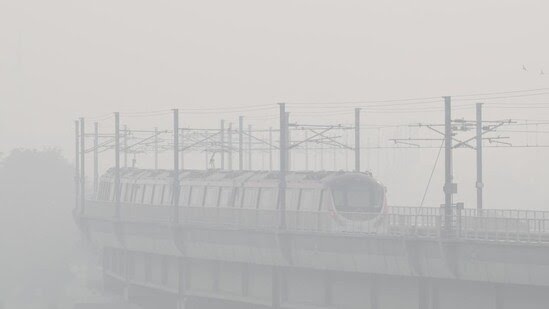
Delhi and the National Capital Region (NCR) faced their worst air quality of the season on Sunday, with visibility dropping to 150 meters in some areas and the Air Quality Index (AQI) hitting the ‘severe plus’ category. In response, the Commission for Air Quality Management (CAQM) enforced Stage IV of the Graded Response Action Plan (GRAP) starting 8 a.m. Monday, introducing stringent measures to curb the crisis.
Delhi’s AQI surged to a hazardous 441 at 4 p.m. on Sunday, marking the second-highest reading this year after January 14’s 447. According to the Central Pollution Control Board (CPCB), AQI rose throughout the day, peaking at 468 by 10 p.m. Meteorologists attribute the worsening pollution to heavy fog, stagnant wind conditions, and winter inversion, which trap pollutants in the lower atmosphere.
Stubble burning also contributed significantly, accounting for 25.2% of the PM2.5 levels in Delhi on Sunday, as per the Decision Support System.
Under GRAP-IV, all construction and demolition activities, including public infrastructure projects like roads, highways, and flyovers, are suspended. Vehicle restrictions are strictly enforced, including a ban on non-essential trucks, non-BS VI compliant light commercial vehicles, and diesel-operated medium and heavy goods vehicles (MGVs and HGVs). Public, municipal, and private offices may operate at 50% capacity, with the rest working remotely.
Schools have been directed to shift to online classes, with only Class 10 and 12 students allowed in-person instruction. The Delhi government is also considering implementing odd-even vehicle regulations to further reduce pollution.
Delhi Chief Minister Atishi announced the suspension of in-person classes for most students and urged residents to stay indoors, particularly children, the elderly, and those with chronic health conditions. Environment Minister Gopal Rai convened a high-level meeting with department heads to ensure the effective implementation of GRAP-IV restrictions.
Anumita Roychowdhury, Executive Director at the Centre for Science and Environment (CSE), highlighted the urgent need for action. “The deepening winter inversion and high local pollution levels demand immediate measures to prevent further deterioration,” she said.
Authorities have issued health advisories urging residents to avoid outdoor activities. Children and vulnerable groups are advised to remain indoors. The CAQM predicts that AQI levels will likely stay in the ‘severe’ or ‘severe plus’ category due to adverse weather conditions.
The air quality crisis highlights the long-standing issue of pollution in Delhi-NCR, exacerbated by winter conditions and agricultural practices like stubble burning. While GRAP measures offer a temporary reprieve, experts emphasize the need for sustained efforts to address pollution sources and mitigate health risks.
With visibility at record lows and air quality at hazardous levels, Delhi-NCR braces for more challenges in the days to come.
Read More: https://thelocaljournalist.com/imd-alert-heavy-rainfall-in-south-india-dense-fog-in-north-india/
